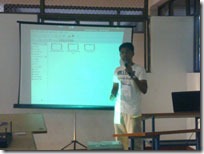 For all people in 4th year and beyond, its GRE season and we decided to catch up with Satish Kumar – who just passed VIT and is now doing his masters in Purdue, USA. Needless to say, Purdue is one of the best universities across the globe and getting there isn’t easy.
For all people in 4th year and beyond, its GRE season and we decided to catch up with Satish Kumar – who just passed VIT and is now doing his masters in Purdue, USA. Needless to say, Purdue is one of the best universities across the globe and getting there isn’t easy.
So, we decided to ask him for an interview about how to approach the entire GRE procedure, and we’re thankful that he agreed to take the time out to answer each one of our questions.
And without further delay, here’s Satish:
Q: How much was your score?
A: my score was 1280/1600 , 800 in quant and 480 in verbal
Q: How important is a good score in GRE?
A: It depends highly on the college, but it is always preferred that you have a full score in the quant section, which in most cases is a requirement (for some good universities). But there are universities which don ask you for a GRE score. So it highly depends on the score. And aim for a score of 1300+ , that is supposed to be a good and safe score.
Q: Any tips on preparing for the GRE?
A: All of us are generally good at GRE math, so you need not concentrate much on the quant, if you have problems, you could solve some sample papers and you would be fine. There are a few areas you would want to perfect yourself before giving the exam such as data interpretation and statistics.
But verbal is the crucial point, don make the mistake of giving GRE without any preparation ( I did), you will realize that there are a lot of words which you would have seen somewhere but you can't recollect. I strongly suggest the Princeton Review's Hit list of words for GRE, they are very useful and have a high occurrence in the actual exam, but nevertheless it is also good if you take a general summer course in one of the many institutes for GRE. Again it highly depends on the person, if you are good at English and vocabulary you might not need any preparation.
Q: What is the application procedure?
A: The procedure is generally like, while you are preparing for GRE and TOEFL you also look at the possible universities you are interested in and shortlist them, once you are done with the exams, you can actively look up the research or work going on in each of the universities and then apply accordingly, most top universities have deadlines in first/second week of December for the following year's fall admissions. So make sure you do things in time. Also look up for Professors/Lecturers/Other people who have worked with you or taught you for writing Letter of Recommendations (LORs) for you. Also start writing your Statement of Purpose (SOP) early and keep revising it.
During the application, you will have to pay some application fee (80-100$) and then fill up a long application form and then submit your SOP, resume and other required documents. You will be asked to enter the details of the persons who would submit LORs for you, the persons will receive an email from the university asking them to submit an LOR for the corresponding student. Most universities follow this system of online submission. After everything is done, you will have to send a copy of your official transcripts to the university via courier (the DHL service in Vellore is awesome, they even come to the university and pick up your packet). So basically all this should be done before the deadline.
Though this is the general flow of events, the steps might vary largely for some universities, so always make sure that you read the steps required to be finished on the concerned universities website etc.
Q: How long does it take for the application results to be released after applying?
A: This again varies largely, but most universities which have deadlines in december start sending out replies by march or mid April.
Q: What should be a student’s strategy while applying for Universities? Which universities should they aim for?
A: The general strategy is that the student picks up some universities which are dream to just try their luck, and then some universities which are safe or obvious (these are mostly lower than the dream universities), and then some super safe universities. So in the worst case you will end up at least in the super safe universities. But mostly people get selects from the safe universities and sometimes even from the dream universities. Also one could use sites such as msinus.com etc for some help, though let me caution you that they are far from accurate.
Q: How should the Visa interviews be approached?
A: Visa interviews are generally easy, but be very meticulous with the base paper work, be very confident whatever it may be, and I have not heard of many rejects. I guess we can talk about the finer aspects at a later appropriate stage.
Q: How difficult is it to get a US visa?
A: It is not very difficult, of all my friends who applied this year (about 15-20) , no one was denied a visa. Visa denials are very rare, especially for VIT students.
Q: How difficult is it to settle down in a university abroad? What were your challenges?
A: The main challenges I/my friends faced in the first weeks were :
getting used to the accent, it is very tough to understand what people speak, but you adjust very fast , so its ok
food and other minor issues like general behaviour ( I did not face problems with these but mentioned them since I have seen people around me struggling with these), traffic rules etc
But don't worry, the people here are very friendly, so you will have almost no problems.
Q: How is the atmosphere in the university? Is there a culture shock?
A: Not much of a shock, I mean coming from VIT at least you can't say that ;). But yeah you need to get used to things and stop staring at girls ! :D
Q: Apart from the universities in the US, what are the other viable options for students from India?
A: I am not really sure about this, you should probably ask someone else.
Q: How hard is it to get financial assistance? What is the procedure to apply for financial assistance?
A: The procedure generally depends on the university and more specifically on the department. If you are lucky enough you would be offered funding when you are selected itself. Other wise you will have to come to the university and look out for opportunities(like in my case). It is not very tough, but depends on the university. Mostly all Indians end up with something or the other after a semester.
Q: How are scholarships awarded? On what basis?
A: I am not really sure about this, there are a huge variety of options here too ... I mean there are fellowships for minorities and then there are merit based scholarships etc, so you can get this information mostly from the university website and after going to the university.

![ani_thumb[1] ani_thumb[1]](http://lh5.ggpht.com/_mhTFfLhAXQU/TD25VdCiDeI/AAAAAAAAADE/bgkzztU28Vo/ani_thumb%5B1%5D_thumb%5B1%5D.jpg?imgmax=800)
![ani_thumb[1] ani_thumb[1]](http://lh3.ggpht.com/_mhTFfLhAXQU/TAUZ-GqpdiI/AAAAAAAAAC8/ENl0db-tP2o/ani_thumb%5B1%5D%5B4%5D.jpg?imgmax=800) This is the second instalment in the series of articles on Cloud Computing. As promised in the previous article, this article will cover two major topics
This is the second instalment in the series of articles on Cloud Computing. As promised in the previous article, this article will cover two major topics



